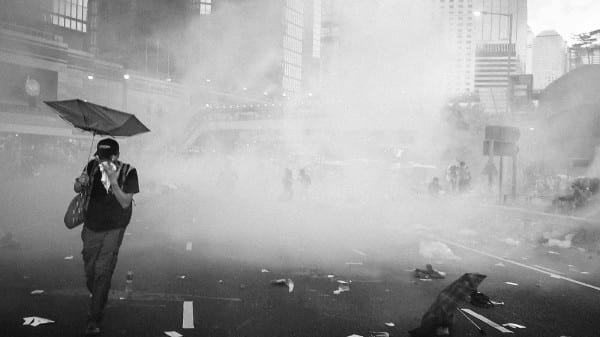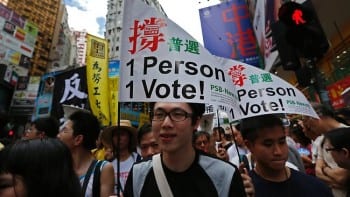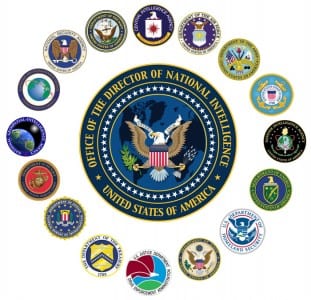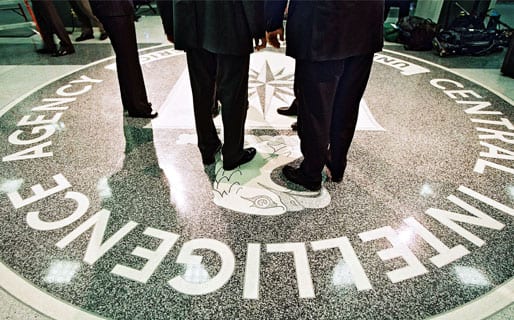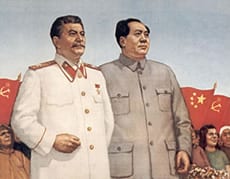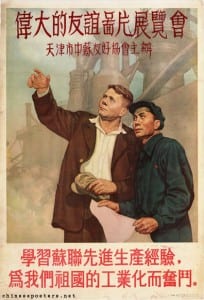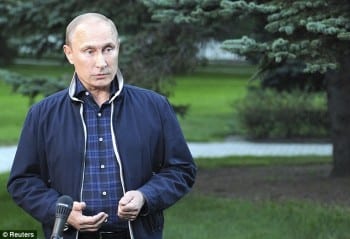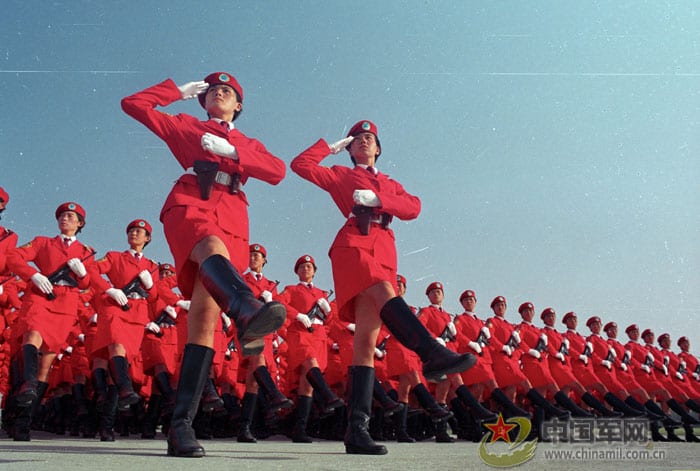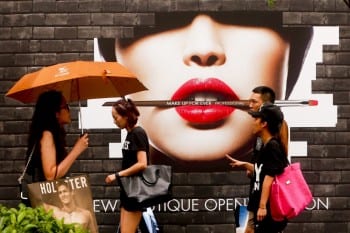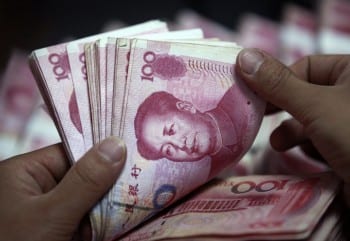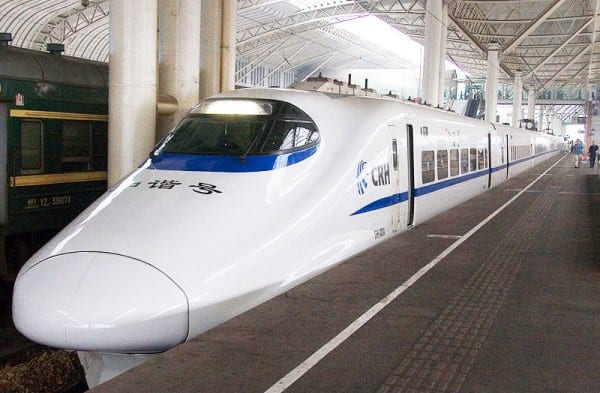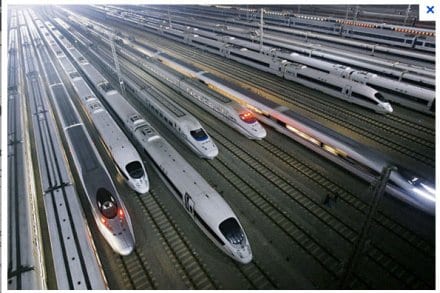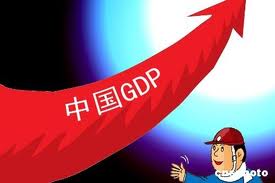[dropcap]D[/dropcap]uring Iraq War II (2003-2011), I used to imagine that the Chinese leadership would gather weekly in the streets of the Forbidden City, singing and dancing to celebrate American idiocy. Year after year, when the U.S. might have faced off against a rising China, as its leaders had long had the urge to do, it was thoroughly distracted by its disastrous invasion and occupation of Iraq. I can't help but think that, with a bombing campaign revving up in Iraq and now Syria, the boots of 1,600 military personnel ever closer to the ground, and talk of more to come, with Iraq War III (2014-date unknown) predicted to go on for years, they are once again rejoicing. For all the talk in recent years about the Obama administration's military “pivot” to Asia, there can be no question that its latest Middle Eastern campaign will put a crimp on its Pacific “containment” planning.
In the meantime, the mood in China has clearly been changing as well. As Orville Schell wrote recently, after a contentious visit to Beijing by 90-year-old Jimmy Carter, the president who more than 30 years ago sponsored a full-scale American rapprochement with the new capitalist version of Communist China:
“In short, what used to be referred to as ‘the West’ now finds itself confronted by an increasingly intractable situation in which the power balance is changing, a fact that few have yet quite cared to acknowledge, much less to factor into new formulations for approaching China. We remain nostalgic for those quaint days when Chinese leaders still followed Deng [Xiaoping's] admonition to his people to ‘hide our capacities and bide our time’ (taoguang yanghui). What he meant in using this ‘idiom’ (chengyu) was not that China should be eternally restrained but that the time to manifest its global ambition had not yet come. Now that it is stronger, however, its leaders appear to believe that their time has at last come and they are no longer willing even to press the comforting notion of ‘peaceful rise’ (heping jueqi).”
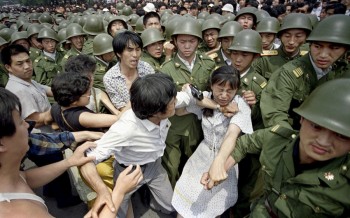
China "democracy" activists being removed. Many are genuine and well intentioned but tools of the West, nonetheless. | click to enlarge
At the moment, of course, the Chinese have their own internal problems, ranging from an economy that might be bubblicious to an Islamic separatist movement in the backlands of Xinjiang Province and the latest Occupy movement making waves in that modernistic Asian financial hub Hong Kong. Nonetheless, go to Beijing and the world looks like a different place. Pepe Escobar, TomDispatch’s peripatetic wanderer on the Eurasian mainland, which he’s dubbed Pipelineistan, has done just that. He's also visited other spots along the future “new Silk Roads” that China wants to establish all the way to Western Europe. He offers a vision of a different Eurasian world than the one reflected in news reports in this country. If you want to understand the planet we may actually be living on in the near future, it couldn’t be more important to take it in. Tom
The Future of a Beijing-Moscow-Berlin Alliance
By Pepe Escobar
A specter haunts the fast-aging “New American Century”: the possibility of a future Beijing-Moscow-Berlin strategic trade and commercial alliance. Let’s call it the BMB.

One of China's new warships. | click to enlarge
Its likelihood is being seriously discussed at the highest levels in Beijing and Moscow, and viewed with interest in Berlin, New Delhi, and Tehran. But don’t mention it inside Washington’s Beltway or at NATO headquarters in Brussels. There, the star of the show today and tomorrow is the new Osama bin Laden: Caliph Ibrahim, aka Abu Bakr al-Baghdadi, the elusive, self-appointed beheading prophet of a new mini-state and movement that has provided an acronym feast -- ISIS/ISIL/IS -- for hysterics in Washington and elsewhere.
No matter how often Washington remixes its Global War on Terror, however, the tectonic plates of Eurasian geopolitics continue to shift, and they’re not going to stop just because American elites refuse to accept that their historically brief “unipolar moment” is on the wane. For them, the closing of the era of “full spectrum dominance,” as the Pentagon likes to call it, is inconceivable. After all, the necessity for the indispensable nation to control all space -- military, economic, cultural, cyber, and outer -- is little short of a religious doctrine. Exceptionalist missionaries don’t do equality. At best, they do “coalitions of the willing” like the one crammed with “over 40 countries” assembled to fight ISIS/ISIL/IS and either applauding (and plotting) from the sidelines or sending the odd plane or two toward Iraq or Syria.
NATO, which unlike some of its members won’t officially fight Jihadistan, remains a top-down outfit controlled by Washington. It’s never fully bothered to take in the European Union (EU) or considered allowing Russia to “feel” European. As for the Caliph, he’s just a minor diversion. A postmodern cynic might even contend that he was an emissary sent onto the global playing field by China and Russia to take the eye of the planet’s hyperpower off the ball.
Divide and Isolate
So how does full spectrum dominance apply when two actual competitor powers, Russia and China, begin to make their presences felt? Washington’s approach to each -- in Ukraine and in Asian waters -- might be thought of as divide and isolate.
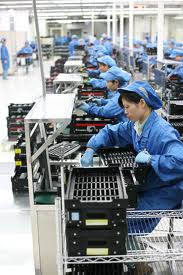
In order to keep the Pacific Ocean as a classic “American lake,” the Obama administration has been “pivoting” back to Asia for several years now. This has involved only modest military moves, but an immodest attempt to pit Chinese nationalism against the Japanese variety, while strengthening alliances and relations across Southeast Asia with a focus on South China Sea energy disputes. At the same time, it has moved to lock a future trade agreement, the Trans-Pacific Partnership (TPP), in place.
In Russia’s western borderlands, the Obama administration has stoked the embers of regime change in Kiev into flames (fanned by local cheerleaders Poland and the Baltic nations) and into what clearly looked, to Vladimir Putin and Russia’s leadership, like an existential threat to Moscow. Unlike the U.S., whose sphere of influence (and military bases) are global, Russia was not to retain any significant influence in its former near abroad, which, when it comes to Kiev, is not for most Russians, “abroad” at all.
For Moscow, it seemed as if Washington and its NATO allies were increasingly interested in imposing a new Iron Curtain on their country from the Baltic to the Black Sea, with Ukraine simply as the tip of the spear. In BMB terms, think of it as an attempt to isolate Russia and impose a new barrier to relations with Germany. The ultimate aim would be to split Eurasia, preventing future moves toward trade and commercial integration via a process not controlled through Washington.
From Beijing’s point of view, the Ukraine crisis was a case of Washington crossing every imaginable red line to harass and isolate Russia. To its leaders, this looks like a concerted attempt to destabilize the region in ways favorable to American interests, supported by a full range of Washington’s elite from neocons and Cold War “liberals” to humanitarian interventionists in the Susan Rice and Samantha Power mold. Of course, if you’ve been following the Ukraine crisis from Washington, such perspectives seem as alien as any those of any Martian. But the world looks different from the heart of Eurasia than it does from Washington -- especially from a rising China with its newly minted “Chinese dream” (Zhongguo meng).
As laid out by President Xi Jinping, that dream would include a future network of Chinese-organized new Silk Roads that would create the equivalent of a Trans-Asian Express for Eurasian commerce. So if Beijing, for instance, feels pressure from Washington and Tokyo on the naval front, part of its response is a two-pronged, trade-based advance across the Eurasian landmass, one prong via Siberia and the other through the Central Asian “stans.”
In this sense, though you wouldn’t know it if you only followed the American media or “debates” in Washington, we’re potentially entering a new world. Once upon a time not so long ago, Beijing’s leadership was flirting with the idea of rewriting the geopolitical/economic game side by side with the U.S., while Putin’s Moscow hinted at the possibility of someday joining NATO. No longer. Today, the part of the West that both countries are interested in is a possible future Germany no longer dominated by American power and Washington’s wishes.
 Moscow has, in fact, been involved in no less than half a century of strategic dialogue with Berlin that has included industrial cooperation and increasing energy interdependence. In many quarters of the Global South this has been noted and Germany is starting to be viewed as “the sixth BRICS” power (after Brazil, Russia, India, China, and South Africa).
Moscow has, in fact, been involved in no less than half a century of strategic dialogue with Berlin that has included industrial cooperation and increasing energy interdependence. In many quarters of the Global South this has been noted and Germany is starting to be viewed as “the sixth BRICS” power (after Brazil, Russia, India, China, and South Africa).
In the midst of global crises ranging from Syria to Ukraine, Berlin’s geostrategic interests seem to be slowly diverging from Washington’s. German industrialists, in particular, appear eager to pursue unlimited commercial deals with Russia and China. These might set their country on a path to global power unlimited by the EU’s borders and, in the long term, signal the end of the era in which Germany, however politely dealt with, was essentially an American satellite.
It will be a long and winding road. The Bundestag, Germany’s parliament, is still addicted to a strong Atlanticist agenda and a preemptive obedience to Washington. There are still tens of thousands of American soldiers on German soil. Yet, for the first time, German chancellor Angela Merkel has been hesitating when it comes to imposing ever-heavier sanctions on Russia over the situation in Ukraine, because no fewer than 300,000 German jobs depend on relations with that country. Industrial leaders and the financial establishment have already sounded the alarm, fearing such sanctions would be totally counterproductive.
China’s Silk Road Banquet
China’s new geopolitical power play in Eurasia has few parallels in modern history. The days when the “Little Helmsman” Deng Xiaoping insisted that the country “keep a low profile” on the global stage are long gone. Of course, there are disagreements and conflicting strategies when it comes to managing the country’s hot spots: Taiwan, Hong Kong, Tibet, Xinjiang, the South China Sea, competitors India and Japan, and problematic allies like North Korea and Pakistan. And popular unrest in some Beijing-dominated “peripheries” is growing to incendiary levels.
The country’s number one priority remains domestic and focused on carrying out President Xi’s economic reforms, while increasing “transparency” and fighting corruption within the ruling Communist Party. A distant second is the question of how to progressively hedge against the Pentagon’s “pivot” plans in the region -- via the build-up of a blue-water navy, nuclear submarines, and a technologically advanced air force -- without getting so assertive as to freak out Washington’s “China threat”-minded establishment.
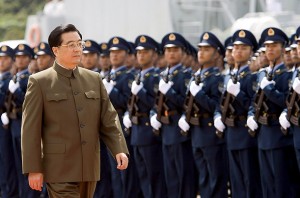
Party leader reviewing honor guard. | click to enlarge
Meanwhile, with the U.S. Navy controlling global sea lanes for the foreseeable future, planning for those new Silk Roads across Eurasia is proceeding apace. The end result should prove a triumph of integrated infrastructure -- roads, high-speed rail, pipelines, ports -- that will connect China to Western Europe and the Mediterranean Sea, the old Roman imperial Mare Nostrum, in every imaginable way.
In a reverse Marco Polo-style journey, remixed for the Google world, one key Silk Road branch will go from the former imperial capital Xian to Urumqi in Xinjiang Province, then through Central Asia, Iran, Iraq, and Turkey’s Anatolia, ending in Venice. Another will be a maritime Silk Road starting from Fujian province and going through the Malacca strait, the Indian Ocean, Nairobi in Kenya, and finally all the way to the Mediterranean via the Suez canal. Taken together, it’s what Beijing refers to as the Silk Road Economic Belt.
China’s strategy is to create a network of interconnections among no less than five key regions: Russia (the key bridge between Asia and Europe), the Central Asian “stans,” Southwest Asia (with major roles for Iran, Iraq, Syria, Saudi Arabia, and Turkey), the Caucasus, and Eastern Europe (including Belarus, Moldova, and depending upon its stability, Ukraine). And don’t forget Afghanistan, Pakistan, and India, which could be thought of as Silk Road plus.
Silk Road plus would involve connecting the Bangladesh-China-India-Myanmar economic corridor to the China-Pakistan economic corridor, and could offer Beijing privileged access to the Indian Ocean. Once again, a total package -- roads, high-speed rail, pipelines, and fiber optic networks -- would link the region to China.
Xi himself put the India-China connection in a neat package of images in an op-ed he published in the Hindu prior to his recent visit to New Delhi. “The combination of the ‘world’s factory’ and the ‘world’s back office,’” he wrote, “will produce the most competitive production base and the most attractive consumer market.”

The Red flag still flies, and its meaning may return. click to enlarge
The central node of China’s elaborate planning for the Eurasian future is Urumqi, the capital of Xinjiang Province and the site of the largest commercial fair in Central Asia, the China-Eurasia Fair. Since 2000, one of Beijing’s top priorities has been to urbanize that largely desert but oil-rich province and industrialize it, whatever it takes. And what it takes, as Beijing sees it, is the hardcore Sinicization of the region -- with its corollary, the suppression of any possibility of ethnic Uighur dissent. People’s Liberation Army General Li Yazhou has, in these terms, described Central Asia as “the most subtle slice of cake donated by the sky to modern China.”
Most of China’s vision of a new Eurasia tied to Beijing by every form of transport and communication was vividly detailed in “Marching Westwards: The Rebalancing of China’s Geostrategy,” a landmark 2012 essay published by scholar Wang Jisi of the Center of International and Strategic Studies at Beijing University. As a response to such a future set of Eurasian connections, the best the Obama administration has come up with is a version of naval containment from the Indian Ocean to the South China Sea, while sharpening conflicts with and strategic alliances around China from Japan to India. (NATO is, of course, left with the task of containing Russia in Eastern Europe.)
An Iron Curtain vs. Silk Roads
The $400 billion “gas deal of the century,” signed by Putin and the Chinese president last May, laid the groundwork for the building of the Power of Siberia pipeline, already under construction in Yakutsk. It will bring a flood of Russian natural gas onto the Chinese market. It clearly represents just the beginning of a turbocharged, energy-based strategic alliance between the two countries. Meanwhile, German businessmen and industrialists have been noting another emerging reality: as much as the final market for made-in-China products traveling on future new Silk Roads will be Europe, the reverse also applies. In one possible commercial future, China is slated to become Germany’s top trading partner by 2018, surging ahead of both the U.S. and France.
A potential barrier to such developments, welcomed in Washington, is Cold War 2.0, which is already tearing not NATO, but the EU apart. In the EU of this moment, the anti-Russian camp includes Great Britain, Sweden, Poland, Romania, and the Baltic nations. Italy and Hungary, on the other hand, can be counted in the pro-Russian camp, while a still unpredictable Germany is the key to whether the future will hold a new Iron Curtain or “Go East” mindset. For this, Ukraine remains the key. If it is successfully Finlandized (with significant autonomy for its regions), as Moscow has been proposing -- a suggestion that is anathema to Washington -- the Go-East path will remain open. If not, a BMB future will be a dicier proposition.
It should be noted that another vision of the Eurasian economic future is also on the horizon. Washington is attempting to impose a Transatlantic Trade and Investment Partnership (TTIP) on Europe and a similar Trans-Pacific Partnership (TPP) on Asia. Both favor globalizing American corporations and their aim is visibly to impede the ascent of the BRICS economies and the rise of other emerging markets, while solidifying American global economic hegemony.
Two stark facts, carefully noted in Moscow, Beijing, and Berlin, suggest the hardcore geopolitics behind these two “commercial” pacts. The TPP excludes China and the TTIP excludes Russia. They represent, that is, the barely disguised sinews of a future trade/monetary war. On my own recent travels, I have had quality agricultural producers in Spain, Italy, and France repeatedly tell me that TTIP is nothing but an economic version of NATO, the military alliance that China’s Xi Jinping calls, perhaps wishfully, an “obsolete structure.”
There is significant resistance to the TTIP among many EU nations (especially in the Club Med countries of southern Europe), as there is against the TPP among Asian nations (especially Japan and Malaysia). It is this that gives the Chinese and the Russians hope for their new Silk Roads and a new style of trade across the Eurasian heartland backed by a Russian-supported Eurasian Union. To this, key figures in German business and industrial circles, for whom relations with Russia remain essential, are paying close attention.
After all, Berlin has not shown overwhelming concern for the rest of the crisis-ridden EU (three recessions in five years). Via a much-despised troika -- the European Central Bank, the International Monetary Fund, and the European Commission -- Berlin is, for all practical purposes, already at the helm of Europe, thriving, and looking east for more.
Three months ago, German chancellor Angela Merkel visited Beijing. Hardly featured in the news was the political acceleration of a potentially groundbreaking project: an uninterrupted high-speed rail connection between Beijing and Berlin. When finally built, it will prove a transportation and trade magnet for dozens of nations along its route from Asia to Europe. Passing through Moscow, it could become the ultimate Silk Road integrator for Europe and perhaps the ultimate nightmare for Washington.
“Losing” Russia
In a blaze of media attention, the recent NATO summit in Wales yielded only a modest “rapid reaction force” for deployment in any future Ukraine-like situations. Meanwhile, the expanding Shanghai Cooperation Organization (SCO), a possible Asian counterpart to NATO, met in Dushanbe, Tajikistan. In Washington and Western Europe essentially no one noticed. They should have. There, China, Russia, and four Central Asian “stans” agreed to add an impressive set of new members: India, Pakistan, and Iran. The implications could be far-reaching. After all, India under Prime Minister Narendra Modi is now on the brink of its own version of Silk Road mania. Behind it lies the possibility of a “Chindia” economic rapprochement, which could change the Eurasian geopolitical map. At the same time, Iran is also being woven into the “Chindia” fold.
So the SCO is slowly but surely shaping up as the most important international organization in Asia. It’s already clear that one of its key long-term objectives will be to stop trading in U.S. dollars, while advancing the use of the petroyuan and petroruble in the energy trade. The U.S., of course, will never be welcomed into the organization.
All of this lies in the future, however. In the present, the Kremlin keeps signaling that it once again wants to start talking with Washington, while Beijing has never wanted to stop. Yet the Obama administration remains myopically embedded in its own version of a zero-sum game, relying on its technological and military might to maintain an advantageous position in Eurasia. Beijing, however, has access to markets and loads of cash, while Moscow has loads of energy. Triangular cooperation between Washington, Beijing, and Moscow would undoubtedly be -- as the Chinese would say -- a win-win-win game, but don’t hold your breath.
Instead, expect China and Russia to deepen their strategic partnership, while pulling in other Eurasian regional powers. Beijing has bet the farm that the U.S./NATO confrontation with Russia over Ukraine will leave Vladimir Putin turning east. At the same time, Moscow is carefully calibrating what its ongoing reorientation toward such an economic powerhouse will mean. Someday, it’s possible that voices of sanity in Washington will be wondering aloud how the U.S. “lost” Russia to China.
In the meantime, think of China as a magnet for a new world order in a future Eurasian century. The same integration process Russia is facing, for instance, seems increasingly to apply to India and other Eurasian nations, and possibly sooner or later to a neutral Germany as well. In the endgame of such a process, the U.S. might find itself progressively squeezed out of Eurasia, with the BMB emerging as a game-changer. Place your bets soon. They’ll be called in by 2025.
